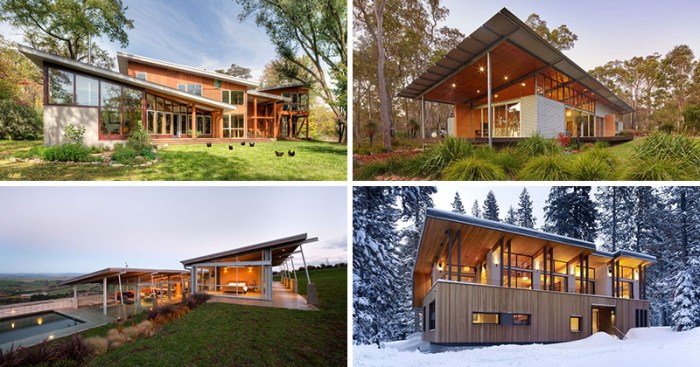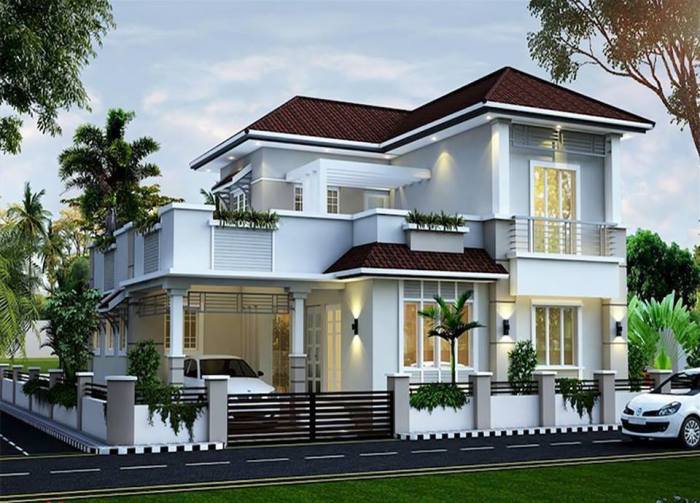Defining Single Slope Roof House Design
Single slope roof house design – Single-slope roofs, also known as shed roofs, are characterized by a single inclined plane extending from a higher to a lower wall. This simple design offers a distinct aesthetic and presents both advantages and disadvantages compared to more complex roof structures. Understanding these aspects is crucial for architects and homeowners alike when considering this architectural choice.
Single slope roof houses offer a modern, minimalist aesthetic, often proving surprisingly versatile in design. For those seeking efficient space utilization within a compact footprint, exploring options like a house design 1000 square feet can be beneficial. Such designs, when paired with a single slope roof, create a visually striking and functional home, maximizing space and minimizing material costs.
Architectural Characteristics of Single Slope Roofs
Single-slope roofs are defined by their uncomplicated geometry. They consist of a single plane sloping in one direction, creating a clean, minimalist profile. The slope angle varies depending on factors like climate, local building codes, and desired aesthetic. A steeper slope is often necessary in areas with high snowfall to facilitate efficient shedding of snow. The roof’s simplicity often translates to a visually modern and uncluttered appearance, making it suitable for contemporary and minimalist architectural styles.
The low profile can also contribute to a sense of horizontal extension, making it a good choice for houses designed to maximize floor space.
Advantages and Disadvantages of Single Slope Roofs, Single slope roof house design
Compared to gable or hip roofs, single-slope roofs offer several advantages. Their simplicity often translates to lower material costs and faster construction times. They are also generally less susceptible to wind damage due to their streamlined profile. However, disadvantages include limited attic space or the complete lack thereof, depending on the slope angle. This can restrict storage options and potentially impact the overall energy efficiency of the house.
Furthermore, single-slope roofs might not be suitable for all climates, particularly those with heavy snowfall, unless a sufficiently steep slope is employed. Gable and hip roofs, on the other hand, offer better ventilation and attic space, but are more complex and expensive to construct.
Examples of Single Slope Roof House Styles Across Architectural Periods
While not as prevalent as gable or hip roofs throughout history, single-slope roofs have appeared in various architectural styles and periods. Modern minimalist homes frequently feature single-slope roofs to emphasize clean lines and functionality. Some contemporary designs incorporate large overhangs to enhance shade and weather protection. In certain vernacular architectural styles, particularly in regions with heavy rainfall or specific building material limitations, single-slope designs were employed for their practicality.
Examples can be found in certain agricultural buildings or simple dwellings adapted to specific geographical conditions. However, it’s important to note that the widespread adoption of single-slope roofs is more recent, largely driven by contemporary architectural trends.
Structural Requirements Comparison of Roof Types
The following table compares the structural requirements of single-slope, gable, and hip roofs. Note that these are general comparisons and specific requirements vary greatly based on factors like span, materials, and local building codes.
| Roof Type | Structural Complexity | Material Requirements | Labor Requirements |
|---|---|---|---|
| Single Slope | Low | Relatively low | Relatively low |
| Gable | Medium | Medium to high | Medium to high |
| Hip | High | High | High |
Design Considerations for Single Slope Roof Houses: Single Slope Roof House Design

Designing a single slope roof house requires careful consideration of various factors to ensure both aesthetic appeal and structural integrity. The simplicity of the design doesn’t negate the importance of thoughtful planning, particularly concerning climate, building codes, material selection, and water management. Ignoring these aspects can lead to costly repairs and potential structural issues down the line.
Climate and Local Building Codes
Climate significantly impacts single slope roof design. In regions with heavy snowfall, a steeper slope is necessary to prevent snow accumulation and potential roof collapse. Conversely, in areas with intense rainfall, a steeper slope aids in rapid water runoff, minimizing the risk of leaks and water damage. Local building codes also play a crucial role, dictating minimum slope requirements, material specifications, and wind load considerations based on the region’s prevailing weather patterns.
For instance, coastal areas might necessitate stronger, more resilient roofing materials to withstand high winds and salt spray. Compliance with these regulations is paramount for obtaining building permits and ensuring the safety and longevity of the structure.
Roofing Material Selection
The choice of roofing material depends heavily on climate, budget, and aesthetic preferences. In hot, sunny climates, materials with high reflectivity, such as light-colored metal roofing or tile, are preferred to minimize heat absorption and reduce cooling costs. In colder climates, materials offering good insulation, such as asphalt shingles or insulated metal panels, are more suitable. Budget constraints also influence material selection; asphalt shingles are generally more affordable than metal roofing or clay tiles, but may have a shorter lifespan.
For example, a homeowner in a desert climate with a limited budget might opt for a durable, light-colored asphalt shingle to balance cost-effectiveness and heat resistance.
Rainwater Management and Gutter Systems
Effective rainwater management is crucial for single slope roofs. Because of the single slope’s design, water flows in one direction, requiring a well-designed gutter system to channel the water away from the foundation. The gutter system needs to be sized appropriately for the roof area and the expected rainfall intensity. Consideration should also be given to downspouts, which should be adequately sized and positioned to prevent water overflow and erosion around the foundation.
In areas with heavy rainfall, it might be necessary to install larger gutters and downspouts, or even incorporate additional drainage features like swales or dry wells to manage excess water effectively. Improper rainwater management can lead to foundation problems, basement flooding, and landscaping damage.
Single Slope Roof House Illustration
Imagine a small, rectangular house with a single slope roof. The house measures 20 feet wide and 30 feet long. The roof has a slope angle of approximately 10 degrees. The roof is covered with dark gray asphalt shingles, chosen for their cost-effectiveness and relatively good durability in the region’s moderate climate. The lower edge of the roofline sits approximately 8 feet above the ground, and the higher edge is 10 feet above the ground, illustrating the gentle slope.
A continuous gutter runs along the lower edge of the roof, leading to two downspouts located at either end of the house, directing water away from the foundation. This design prioritizes simplicity and functionality, suitable for a small residential dwelling in a temperate climate.
Single Slope Roof House Aesthetics and Functionality

Single-slope roofs, while seemingly simple, offer a surprising range of aesthetic and functional possibilities. Their clean lines and uncluttered profile lend themselves to both modern and traditional designs, making them a versatile choice for homeowners seeking a unique architectural statement. The functionality, however, extends beyond the purely visual, impacting interior space and natural light in significant ways.The aesthetic appeal of a single-slope roof is significantly enhanced by the choice of exterior finishes.
Careful consideration of these materials can transform a basic design into a stunning architectural feature.
Exterior Finish Choices and Their Impact
The selection of siding, stone, or other exterior materials profoundly impacts the overall aesthetic of a single-slope roof house. For instance, a modern design might pair sleek metal siding with a flat, low-slope roof, creating a minimalist and contemporary feel. The clean lines of the metal complement the simplicity of the roofline, resulting in a cohesive and visually appealing design.
Conversely, a more traditional aesthetic might incorporate natural stone or wood siding, creating a rustic charm that contrasts beautifully with the clean lines of the roof. The texture of the stone or wood can add visual interest and warmth, softening the potentially stark impression of a single-slope roof. A combination of materials, such as using stone for the lower portion of the house and wood siding higher up, can also create a visually dynamic and layered effect.
The color palette chosen for the exterior finishes further contributes to the overall aesthetic; neutral tones can create a sense of calm and sophistication, while bolder colors can add vibrancy and personality.
Interior Design Implications of Single Slope Roofs
The single-slope roof’s design inherently influences the interior space, particularly ceiling height and natural light. A low-slope roof will generally result in lower ceilings in at least one part of the house, which can be both a challenge and an opportunity. Lower ceilings in certain areas can create a more intimate and cozy atmosphere, particularly in bedrooms or smaller living spaces.
However, careful planning is required to ensure sufficient headroom throughout the house. Conversely, a higher single slope roof can offer dramatic, vaulted ceilings in larger areas, enhancing the sense of spaciousness. The orientation of the slope also affects natural light. A south-facing slope in the Northern Hemisphere, for instance, can maximize solar gain during the winter months, reducing energy costs.
Single Slope Roofs in Modern and Traditional Designs
Single-slope roofs are remarkably adaptable to diverse architectural styles. In modern architecture, their clean lines and minimalist aesthetic are frequently employed. Imagine a long, low-slung structure with a single, gently sloping roof, clad in smooth stucco or metal panels, and featuring large windows to maximize natural light and views. This design embodies the principles of modernism – simplicity, functionality, and a seamless integration with the surrounding environment.
In contrast, traditional styles can incorporate a single-slope roof to create a more rustic or farmhouse aesthetic. Here, the roof might be steeper, covered with shingles or tiles, and complemented by features like exposed beams or a wraparound porch. The key difference lies in the materials, details, and overall proportions used to achieve the desired aesthetic.
Maximizing Natural Light in a Single Slope Roof House
The effective use of natural light is crucial in single-slope roof houses, particularly those with lower ceilings. Several strategies can significantly enhance light penetration and distribution.
- Install large windows along the higher side of the slope to maximize light intake.
- Use skylights strategically placed to introduce light into deeper areas of the house.
- Employ light-colored interior finishes, such as walls and flooring, to reflect natural light effectively.
- Incorporate reflective surfaces, such as mirrors, to bounce light into darker corners.
- Minimize the use of heavy curtains or blinds that could obstruct natural light.
Question & Answer Hub
What is the typical slope angle for a single slope roof?
The ideal slope angle varies depending on climate and local building codes, typically ranging from 2:12 to 12:12 (2-12 degrees).
How much does a single slope roof cost compared to other roof types?
Costs are highly variable depending on materials, size, and complexity, but single slope roofs are often more affordable due to their simpler design and reduced material needs compared to gable or hip roofs.
Can I add dormers to a single slope roof?
Yes, dormers can be added to break up the monotony of a large single slope roof and increase interior space and light.
What are the best roofing materials for a single slope roof?
Many materials work well, including asphalt shingles, metal roofing, and tile, with the best choice depending on budget, climate, and aesthetics.
